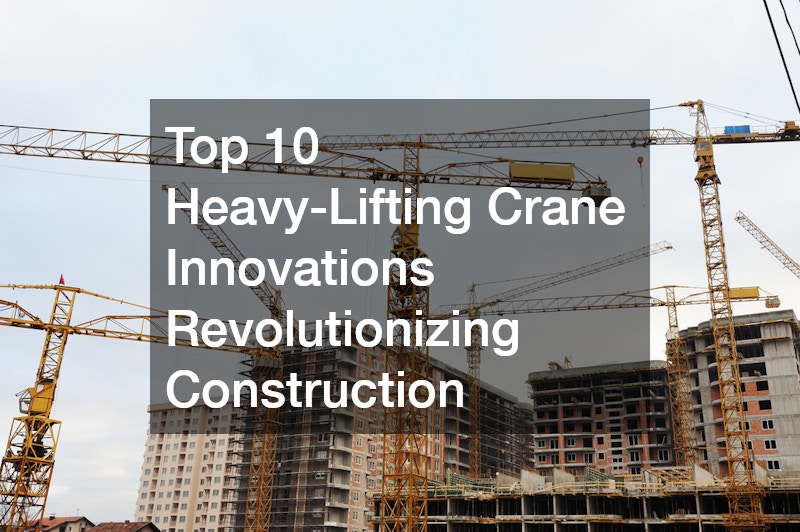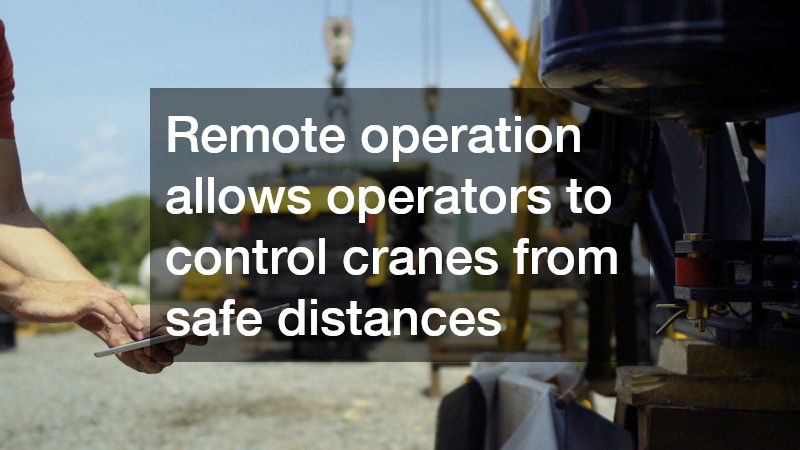
Highlights:
-
Advanced load management systems improve safety and operational efficiency.
-
Hybrid and electric cranes reduce environmental impact and operational costs.
-
Modular crane designs allow for rapid assembly and flexible deployment.
-
Automation and remote operation enhance precision and minimize human error.
-
High-capacity cables and ropes increase lifting power and durability.
-
Telescopic booms enable flexible reach in constrained spaces.
-
Predictive maintenance reduces downtime and extends crane lifespan.
The construction industry has always relied on cranes to lift, move, and place heavy loads with precision. Over the years, innovations in crane technology have transformed the way projects are executed, making construction faster, safer, and more efficient. From towering skyscrapers to massive bridges, heavy-lifting cranes have become indispensable tools in modern construction. This article explores the top heavy-lifting crane innovations and examines how they are reshaping the industry while referencing the practices of the top 10 heavy-lifting crane companies that lead the field.
1. Advanced Load Management Systems
One of the most significant innovations in heavy-lifting cranes is the integration of advanced load management systems. These systems allow operators to monitor weight distribution, wind conditions, and load stability in real-time. With sophisticated sensors and onboard computers, cranes can detect potential hazards before they occur, reducing the risk of accidents, equipment damage, and costly project delays.
-
Load-sensing technology ensures cranes do not exceed safe operating limits, providing peace of mind during critical lifts.
-
Stability monitoring accounts for environmental factors like wind, uneven terrain, and shifting loads.
-
Digital interfaces provide operators with real-time data on load position, angle, and stress, allowing for more precise adjustments.
-
Safety alerts automatically engage if a dangerous condition is detected, helping operators take corrective action quickly.
This innovation has not only improved safety but also enhanced productivity. The adoption of advanced load management systems has become a benchmark for the top 10 heavy-lifting crane companies, which prioritize safety, efficiency, and reliability in every project they undertake. Many large-scale construction projects now rely heavily on these systems to ensure that heavy loads are moved with minimal risk to both workers and infrastructure.
2. Hybrid and Electric-Powered Cranes
Environmental sustainability has become a major concern in construction. Traditional diesel-powered cranes consume large amounts of fuel and produce significant emissions, which contribute to pollution and high operational costs. In response, crane manufacturers have introduced hybrid and fully electric cranes. These innovations reduce carbon footprints, lower fuel costs, and often improve operational efficiency.
-
Hybrid cranes combine diesel engines with electric motors to minimize emissions while maintaining high lifting capacity.
-
Fully electric cranes operate quietly, making them ideal for urban construction sites with noise restrictions.
-
Regenerative braking systems in some models recycle energy to power other crane functions, increasing efficiency.
-
Lower operational costs result from reduced fuel consumption, less frequent maintenance, and longer equipment lifespan.
Among the top 10 heavy-lifting crane companies, many are investing heavily in electric crane technology to meet stringent environmental regulations and respond to client demands for greener construction practices. By adopting hybrid and electric cranes, construction firms can not only reduce their environmental impact but also demonstrate a commitment to sustainable development—a growing consideration in today’s building projects.
3. Modular Crane Designs
Modular cranes are designed for flexibility and rapid assembly, making them ideal for complex and large-scale construction projects. Instead of transporting a single massive unit, modular cranes can be shipped in parts and assembled on-site, which reduces transportation costs and logistical challenges.
-
Easily transportable components allow deployment in remote or congested areas where traditional cranes may be impractical.
-
Scalable configurations can handle a variety of project sizes, from industrial plants to multi-story commercial buildings.
-
Quick assembly and disassembly reduce project downtime, allowing construction to proceed smoothly.
-
Customization options let engineers tailor cranes to meet specific project requirements, such as height, reach, or load capacity.
Leading heavy-lifting crane companies in the top 10 often provide modular solutions for mega projects like stadiums, power plants, and industrial facilities. This modular approach not only improves efficiency but also enables cranes to be reused across multiple projects, maximizing return on investment for construction firms.
4. Automation and Remote Operation
Automation is transforming how cranes are operated. Remote-controlled and semi-autonomous cranes enhance precision, reduce human error, and improve safety, particularly in hazardous environments such as offshore platforms or high-altitude construction sites.
-
Remote operation allows operators to control cranes from safe distances, reducing exposure to dangerous situations.
-
Automated movements can follow pre-programmed paths for repetitive tasks, increasing productivity.
-
Collision detection systems prevent accidents in crowded construction areas where multiple pieces of equipment operate simultaneously.
-
AI-driven optimization calculates the most efficient lifting paths for heavy loads, minimizing unnecessary movements.
The top 10 heavy-lifting crane companies are leading the integration of automation, offering clients solutions that maximize productivity and minimize risk. Automation is particularly beneficial in projects requiring multiple cranes operating in tandem, where precise coordination is critical to avoid accidents and ensure smooth operations.
5. High-Capacity Cables and Ropes
The strength of a crane depends heavily on the quality of its cables and ropes. Recent innovations in materials and engineering have produced ropes with higher tensile strength, improved wear resistance, and longer lifespans.
-
Ultra-high-molecular-weight fibers increase load capacity while reducing rope weight, improving crane efficiency.
-
Corrosion-resistant coatings extend durability in harsh weather and corrosive environments.
-
Dynamic load adjustments prevent cable snapping under sudden weight shifts or unexpected stress.
-
Enhanced safety inspections use sensors to detect wear, fraying, or tension changes, preventing failures before they occur.
Such advancements are standard among the top 10 heavy-lifting crane companies, ensuring their cranes meet stringent safety and performance requirements. By combining these advanced cables with modern crane designs, operators can lift heavier loads more safely than ever before.
6. Telescopic Boom Technology
Telescopic boom cranes allow operators to extend and retract the boom for variable reach without changing the crane’s position. This flexibility is essential for urban construction sites where space is limited and precise positioning is required.
-
Variable boom lengths provide access to hard-to-reach areas without repositioning the entire crane.
-
Hydraulic extension systems allow operators to control boom length and angle with pinpoint accuracy.
-
Lightweight yet durable materials maintain structural strength without adding unnecessary weight.
-
Compact storage and transport facilitate moving cranes between job sites efficiently.
By employing telescopic technology, heavy-lifting crane companies can tackle projects that would have been impossible with traditional fixed-boom cranes, particularly in areas where space constraints make traditional setups impractical.
7. Real-Time Monitoring and Predictive Maintenance
Maintenance innovations have dramatically improved crane reliability. Real-time monitoring systems track crane performance and predict when maintenance is needed, significantly reducing unexpected downtime.
-
Sensors track mechanical stress, hydraulic performance, and operational hours, providing a detailed overview of crane health.
-
Predictive maintenance algorithms forecast potential component failures, allowing proactive intervention.
-
Remote diagnostics allow engineers to troubleshoot issues without stopping operations.
-
Cost savings result from preventing emergency repairs and extending the lifespan of the crane.
These features are critical for leading operators in the top 10 heavy-lifting crane companies, where project timelines are tight and safety cannot be compromised. Predictive maintenance ensures that cranes remain reliable even in demanding construction environments.
8. Heavy-Lifting Cranes for Extreme Environments
Construction in extreme environments, such as offshore oil rigs, mountainous regions, or arctic conditions, requires specialized cranes capable of performing in harsh conditions.
-
Cold-resistant hydraulics maintain full functionality in sub-zero temperatures.
-
Corrosion-resistant materials protect against saltwater exposure and chemical damage.
-
Enhanced anchoring systems prevent instability on uneven or unstable terrain.
-
All-weather operation capabilities ensure minimal project delays, regardless of environmental conditions.
The top 10 heavy-lifting crane companies often lead the market in designing cranes for these challenging applications, ensuring projects in extreme environments are completed safely and efficiently.
9. 360-Degree Rotational Cranes
Modern cranes now feature full 360-degree rotation, allowing operators to move loads around a site without repositioning the crane. This innovation increases efficiency and reduces time wasted on maneuvering heavy loads.
-
Continuous rotation enables precise placement of materials at any angle.
-
Compact footprint reduces space requirements, making it ideal for dense urban construction sites.
-
Improved operator control allows for complex lifts and delicate positioning.
-
Integrated safety systems prevent tipping and stabilize loads during rotation.
This type of innovation is common among the top 10 heavy-lifting crane companies, supporting large-scale projects that demand both precision and speed.
10. Integration with Construction Software
Digital integration has allowed cranes to communicate with construction management software, facilitating better project coordination and operational efficiency.
-
3D modeling compatibility enables operators to visualize lifts before execution, reducing errors.
-
Project management integration ensures that crane operations align with project timelines and material handling schedules.
-
Data logging and reporting provide accountability, helping project managers monitor progress and compliance.
-
Collaborative platforms allow multiple cranes on the same site to work in harmony, avoiding conflicts and downtime.
Leading operators in the top 10 heavy-lifting crane companies leverage these systems to provide clients with smarter, more connected construction solutions. Integration with software not only improves efficiency but also enhances safety and reduces operational costs.
In Summary
The construction industry has been transformed by innovations in heavy-lifting crane technology. From hybrid power sources and modular designs to automated operations and predictive maintenance, modern cranes are safer, more efficient, and more environmentally friendly than ever before. These innovations allow the top 10 heavy-lifting crane companies to execute complex projects that would have been unimaginable a few decades ago.
By embracing these advancements, construction firms can improve safety, reduce costs, and accelerate project timelines, ultimately driving progress in an industry that continues to shape our world. Whether building skyscrapers, bridges, or industrial complexes, heavy-lifting cranes remain at the heart of modern construction, pushing the boundaries of what is possible.

